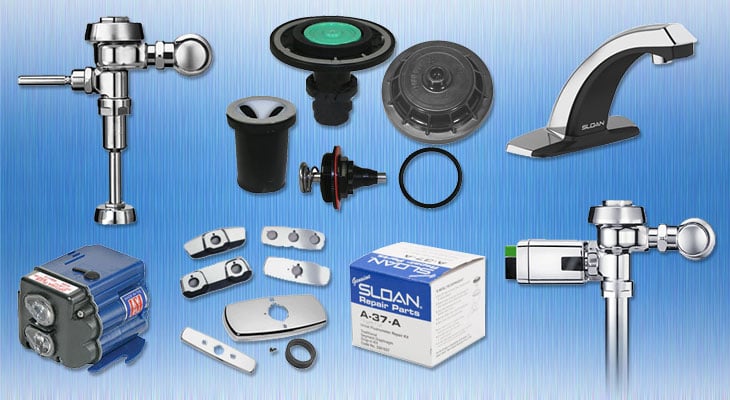
A Complete Troubleshooting Guide for Sloan Faucets

Unresponsive Sensor
Sensor-activated Sloan sink faucets are ideal options for any commercial restroom. Their smart design eliminates shared surfaces throughout your bathroom environment and reduces the chances of cross-contamination. Consequently, these faucets slow the spread of illness within your building and create a more hygienic and welcoming space. However, sensor parts and elements are occasionally prone to technical issues, especially unresponsiveness.
If your automatic fixture is unresponsive to movement, start by checking the sensor eye for any obstructions. In some cases, technicians fail to remove the adhesive label that covers the sensor eye during the installation process, causing these technical complications. Alternatively, sticky residue left over from installation can also interfere with the sensor's functions. Give the sensor eye a thorough wipe-down with safe chemical cleaning products and a microfiber towel to ensure a clean and responsive device.
Another cause for unresponsiveness is the "Permanent Off" setting being activated on your faucet. Depending on your fixture model, this button is typically found around the throat of your device. Simply press this button one time to disengage "Permanent Off" and resume normal operations. If these troubleshooting methods prove unsuccessful, it's highly recommended that you contact your parts distributor or the Sloan Valve Company Installation and Engineering Department-you can find their contact information in your faucet installation instructions or user manual.
Slow or Strained Dribble
Another common issue for automated and non-sensor Sloan sink faucets is a slow or strained dribble rather than continuous water delivery. Aside from being a massive inconvenience that negatively impacts the welcoming nature of your restroom environment, a slow or strained sink faucet is actually a major health hazard concern. Without the proper water pressure and delivery, patrons cannot adequately wash their hands and prevent the spread of illness throughout your building.
Fortunately, these complications are quite simple to fix and often don't require replacement or repair services; there are three probable causes worth considering before contacting Sloan or your parts distributor. First, check that the sink's water supply is fully open and functional. Next, inspect the water supply stop strainer for any excess debris or buildup-if this part is compromised, clean or replace the filter immediately. If these two quick fixes prove unsuccessful, focus your attention on the aerator.
An aerator is a small mesh dish near your sink faucet's spray tips. These surprisingly crucial components are responsible for turning supply water into consistent streams, reducing spillage and overall surface messes. Aerators accomplish this function by limiting your water delivery to just around two gallons per minute. When damaged or clogged, however, the aerator is unable to control the water delivery, leading to slow or strained dribbles. Simply unscrew the damaged aerator and remove any present debris or replace the component entirely. If replacing or repairing the aerator doesn't solve your water delivery problems, there's a good possibility that your unit is faulty.
Alternate Complications: Continuous Water Delivery
Slow or strained dribbling isn't the only water delivery complication that hardwired and battery-powered Sloan faucets face. Unstoppable water delivery is less common but much more concerning. In fact, if your automatic Sloan sink faucet cannot stop dispensing a stream of water, it's most likely due to malfunction or device defect. Contact your parts distributor and the Sloan Installation and Engineering Department for further assistance.
Temperature Range
Sink faucet temperature ranges are essential for ensuring patrons have access to sanitary water supplies that they can adjust to their comfort. It's not uncommon for Sloan faucets to experience miscalibrated temperature ranges. Consequently, patrons are less likely to enjoy their commercial restroom experience and, in certain cases, they may lack proper hot water for hygienic hand-cleaning practices. Typically, there are two main culprits for temperature range complications-an issue with your water supply or the manual temperature mechanism located near the throat of your faucet.
For complications regarding your water supply, inspect your supply stops for misalignment or signs of improper installation. Additionally, ensure your building's plumbing infrastructure isn't currently experiencing a related complication that may exacerbate temperature range issues. If your model features a built-in manual mixing valve and lever, adjust the mechanism until you reach your desired water temperature range. For most Sloan faucets, turning the mixing valve clockwise decreases water temperature, while counterclockwise turns increase the heat.
Hardwired Faucet Considerations
Not all automated Sloan sink faucets receive power from batteries. In fact, many businesses opt for hardwired products since these fixtures don't require battery replacements and are very simple to maintain and troubleshoot. However, one common complication for many hardwired Sloan sink faucets is a malfunctioning LED display, especially when power is connected to the fixture.
For example, it's possible that the green indicator light doesn't display when your sink is fully-powered. In this situation, it's recommended that you restart your electrical system, disconnect the sensor connection within the device, and unplug your hardwired faucet for about 10 seconds. Then, reconnect the above components and test your Sloan faucet. If this solution proves unsuccessful, there's most likely a larger issue with your faucet or the building's electrical system itself, which may require the services of an electrician or plumbing technician.


